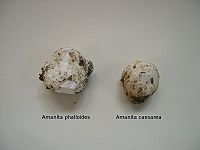
Universal veil
Encyclopedia


Mycology
Mycology is the branch of biology concerned with the study of fungi, including their genetic and biochemical properties, their taxonomy and their use to humans as a source for tinder, medicinals , food and entheogens, as well as their dangers, such as poisoning or...
, a universal veil is a temporary membranous tissue that fully envelops immature fruiting bodies of certain gilled mushrooms. The developing Caesar's mushroom
Amanita caesarea
Amanita caesarea, commonly known in English as Caesar's Mushroom, is a highly regarded edible mushroom in the genus Amanita, native to southern Europe and North Africa. It has a distinctive orange cap, yellow gills and stem. Similar orange-capped species occur in North America and India...
(Amanita caesarea), for example, which may resemble a small white sphere at this point, is protected by this structure. The veil will eventually rupture and disintegrate by the force of the expanding and maturing mushroom, but will usually leave evidence of its former shape with remnants. These remnants include the volva
Volva (mycology)
The volva is a mycological term to describe a cup-like structure at the base of a mushroom that is a remnant of the universal veil. This macrofeature is important in wild mushroom identification due to it being an easily observed, taxonomically significant feature which frequently signifies a...
, or cup-like structure at the base of the stipe
Stipe (mycology)
thumb|150px|right|Diagram of a [[basidiomycete]] stipe with an [[annulus |annulus]] and [[volva |volva]]In mycology a stipe refers to the stem or stalk-like feature supporting the cap of a mushroom. Like all tissues of the mushroom other than the hymenium, the stipe is composed of sterile hyphal...
, and patches or "warts" on top of the cap
Pileus (mycology)
The pileus is the technical name for the cap, or cap-like part, of a basidiocarp or ascocarp that supports a spore-bearing surface, the hymenium. The hymenium may consist of lamellae, tubes, or teeth, on the underside of the pileus...
. This macro
Macroscopic
The macroscopic scale is the length scale on which objects or processes are of a size which is measurable and observable by the naked eye.When applied to phenomena and abstract objects, the macroscopic scale describes existence in the world as we perceive it, often in contrast to experiences or...
feature is useful in wild mushroom identification because it is an easily observed, taxonomically significant feature. It is a character present among species of basidiomycete fungi
Basidiomycota
Basidiomycota is one of two large phyla that, together with the Ascomycota, comprise the subkingdom Dikarya within the Kingdom Fungi...
belonging to the genera Amanita
Amanita
The genus Amanita contains about 600 species of agarics including some of the most toxic known mushrooms found worldwide. This genus is responsible for approximately 95% of the fatalities resulting from mushroom poisoning, with the death cap accounting for about 50% on its own...
and Volvariella
Volvariella
Volvariella is a genus of mushrooms with deep salmon pink gills and spore prints. They lack a ring, and have an Amanita-like volva at the stem base. Some species of Amanita look similar, but Amanita has white spores and often have a ring. Since the gills of young Volvariella are white at first,...
. This has particular importance due to the disproportionately high number of potentially lethal species contained within the former genus.
A membrane enveloping immature fruiting bodies of gasteroid fungi resembles a universal veil, but is called a peridium
Peridium
The peridium is the protective layer that encloses a mass of spores in fungi. This outer covering is a distinctive feature of the Gasteromycetes.-Description:...
.

